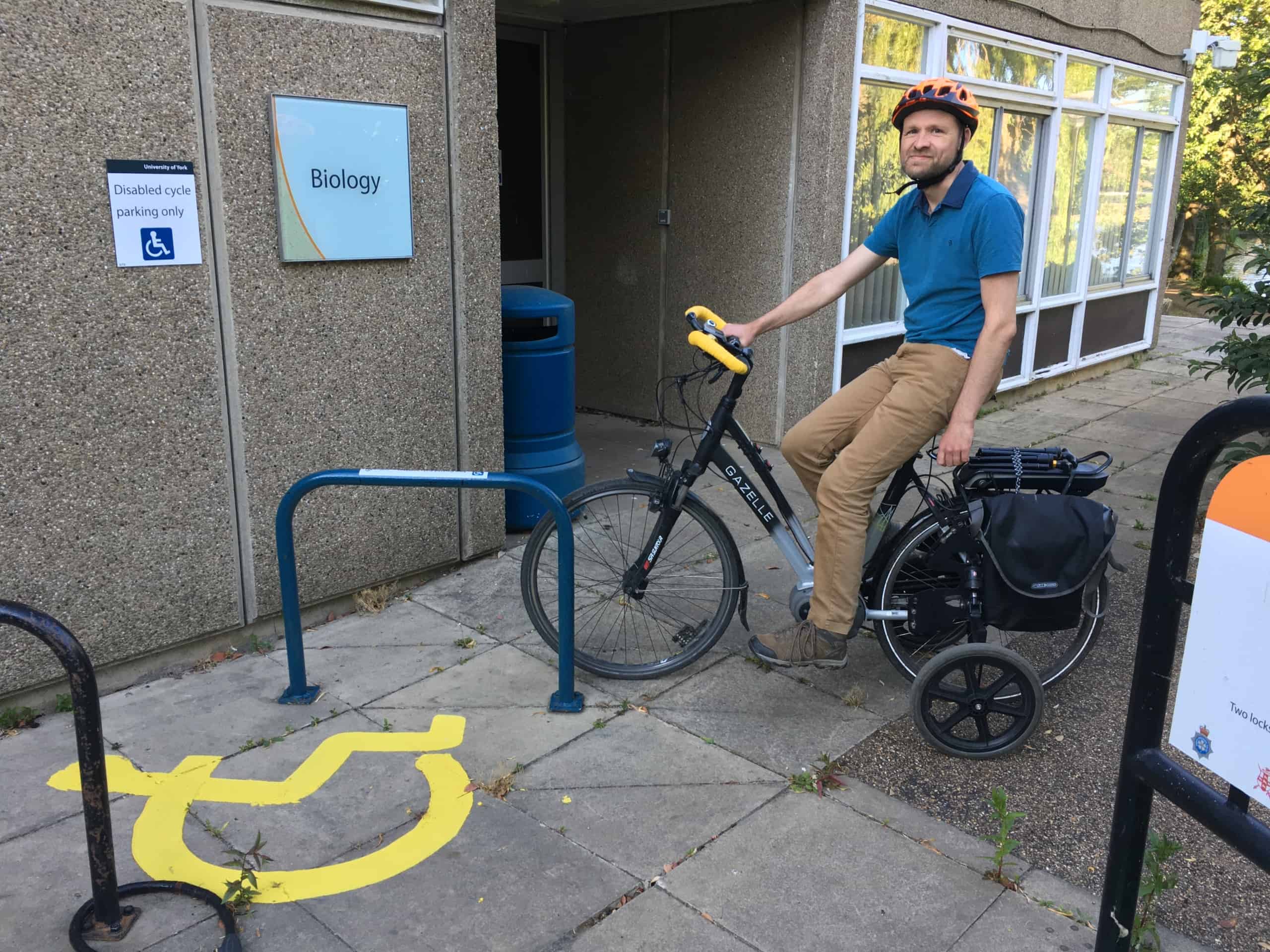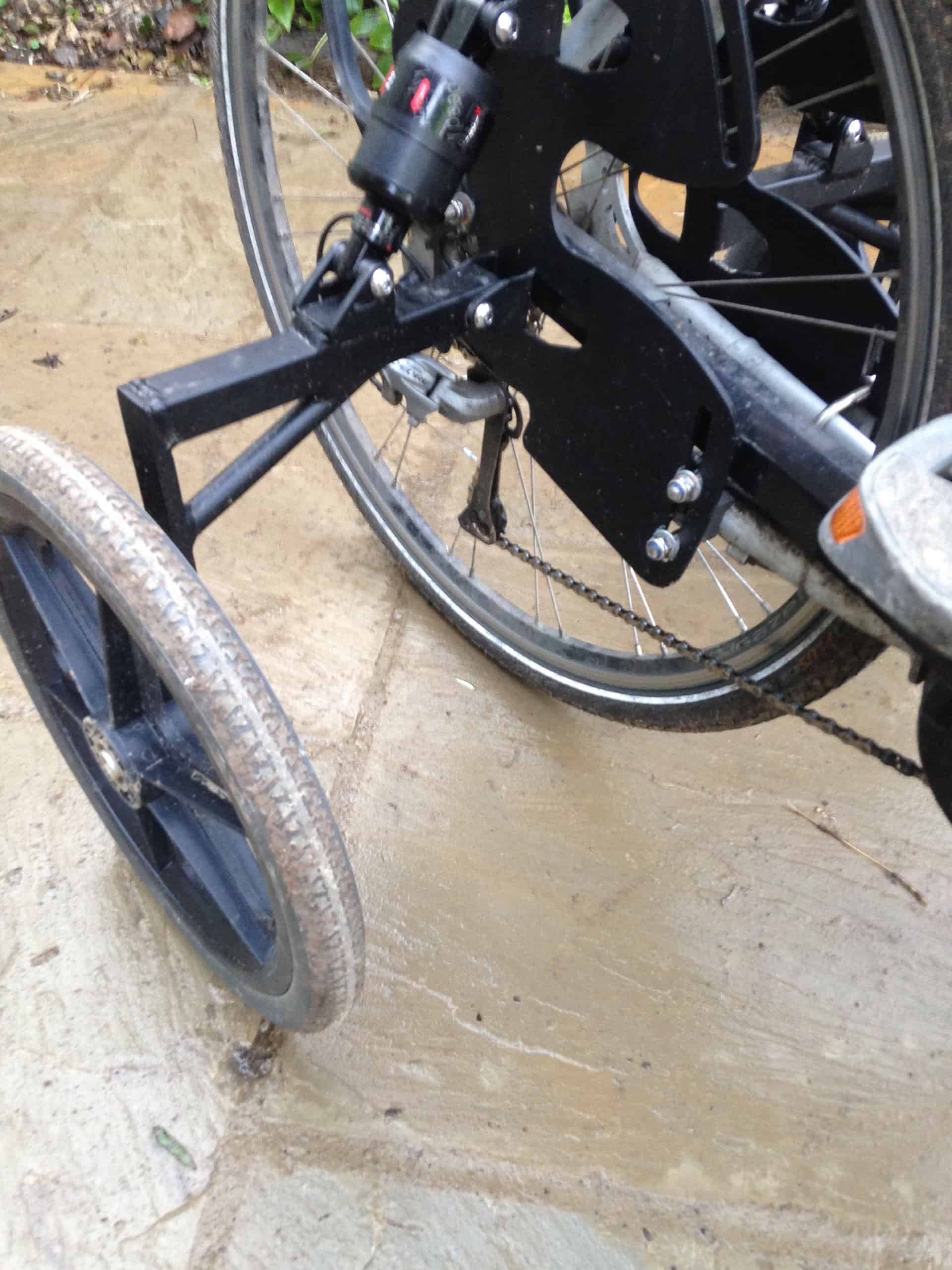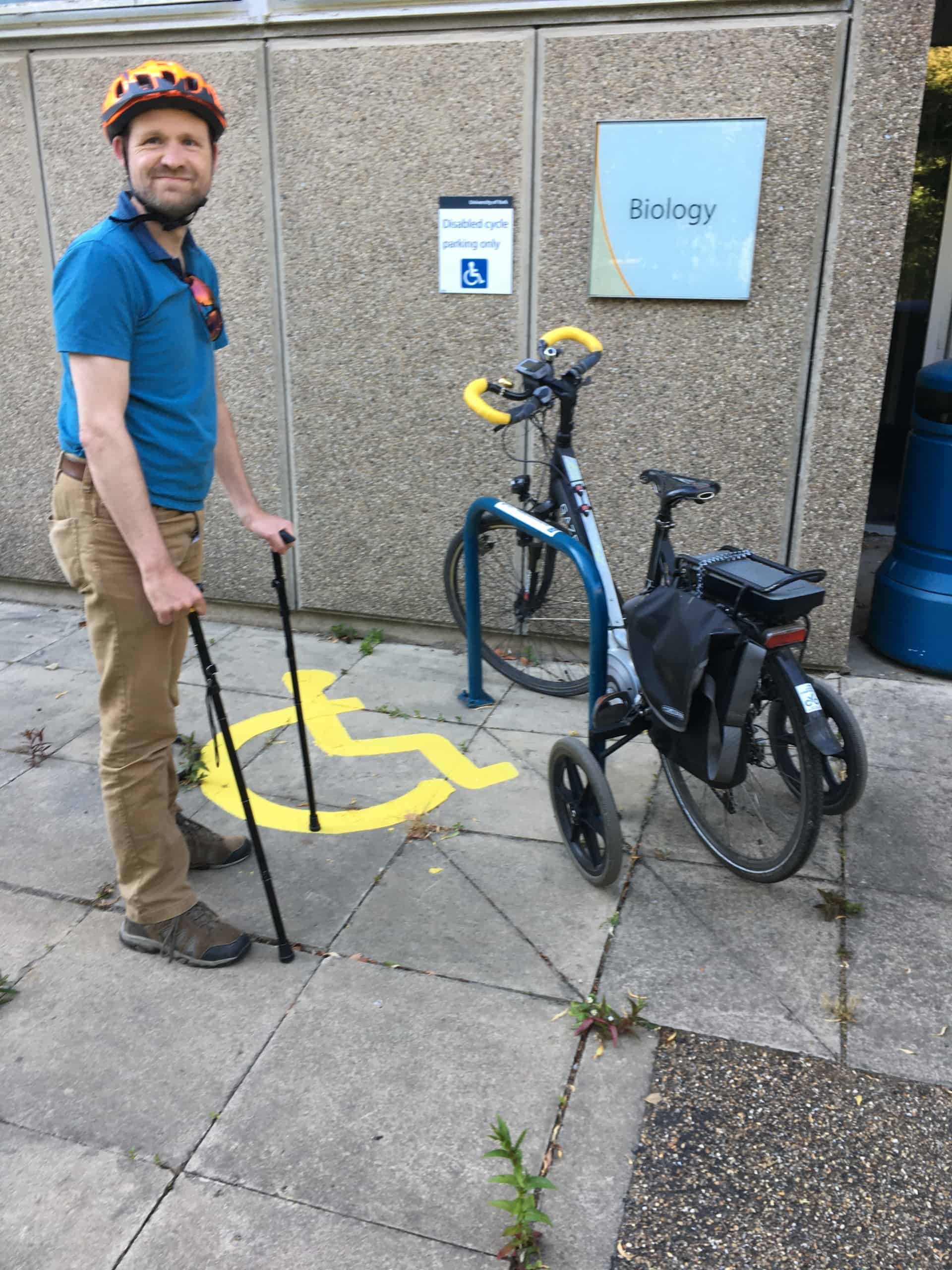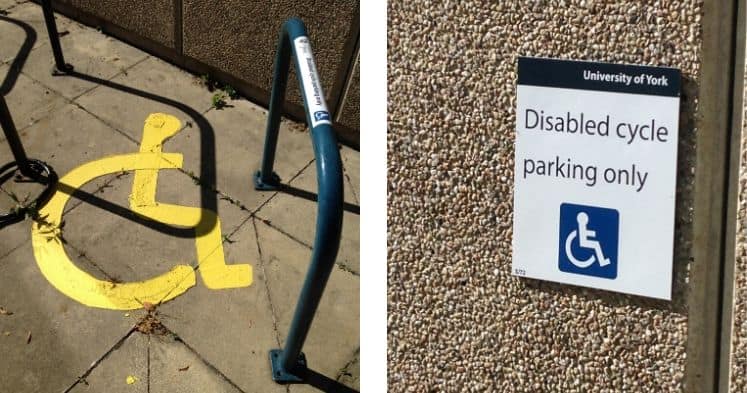One of our goals is to help increase peer support among Disabled people who cycle and those who don’t, or who have questions about where next on their cycling journey. We sure know we don’t have all the answers, and we always find that the best person to “tell it as it is” is someone who’s been through it themselves. For example, we’re often asked about the pros and cons of adult stabilisers, but we’ve had no real experience in that area to-date. So we’re extremely pleased that Jamie Wood has agreed for us to re-post the content of a recent blog post he wrote on exactly that topic. We hope you enjoy it as much as we did.

In 2018 we piled our four bikes onto our car and set off for Ireland via the Liverpool/Belfast ferry. We cycled semi-independently for a week (in good weather) in a loop from Donegal Town. We covered well over 100km including some impressive ascents and descents.
In 2019 we piled our four bikes onto our car and set off for the Netherlands via the Harwich/Hook of Holland ferry. We cycled in Delft and then various day routes in the far east of the country including river crossings and pedal powered trips into both Belgium and Germany.
With multiple sclerosis I treasure time I can spend doing things with my whole family and my disability not being centre stage and dictating what is possible. Sadly, some 6 months ago I reluctantly concluded I was no longer safe on my lightly adapted, but otherwise standard, two wheel e-bike. I was fine when I was moving, but stopping and starting was becoming a lottery. I had the energy for only a few starts per ride and unexpected stops were becoming a danger. So, I needed more wheels, but how many? And where? And how?
This is very much my account of what I have done to my bike to make it a cycle I can use. What works for me may not work for everyone, but hopefully I can layout the logic of why I chose what I did and why it works for me.
First of all, me. I have multiple sclerosis. I’m now in the hinterland between the relapse-remitting and secondary progressive forms of the condition. I tire easily and my walking range has shrunk alarming. It is pretty much non existent now without sticks, and a few hundred metres on a good day with. A few too many falls when walking and a cracked rib or two have damaged my hitherto gung-ho confidence. Cycling has been a massive escape from this. I was never a committed cyclist before, just a regular utility cyclist – it is the quickest way to get around where I live. Disability has changed that. It is now the only way I can get around independently. Shifting to an e-bike early has enabled me to keep cycling and try some really amazing challenges.
Second, the bike. Well over 5 years ago, after much debate, a saved up and bought a front wheel motor gazelle e-bike as my primary commuting vehicle from my local bike shop, cycle heaven. Then, after its motor broke and gazelle stepped up, I was able to replace it, at cost, with a more advanced bike: a Chamonix t10 with a Bosch bottom bracket motor. With a bit of extra tinkering – ergo pedals, butterfly bars, new gearing and, most importantly so I could get my feet on the floor, an air pressure drop saddle. Cycle heaven have been amazing in providing the support for me to make these changes and adjust the bike as my condition has changed.
So, the choices. Extra wheels come in all manner of ways on a new bike. I could go delta trike, upright or recumbent, I could go tadpole, upright or recumbent, or something more exotic. The recumbent trikes I am familiar with, and they are superb machines, either as deltas (I had a go on a Hawser) or as tadpoles (I had a go on an ICE trike). They were great, but with MS, gravity is really important to help you and you use subtly different muscle groups on a recumbent; I found it hard going. So, uprights. The problem with uprights is moving them around. They are big beasts. I have done many of my trips involving moving the bike both by train or by car. Moving an upright trike with a car either means a trailer, or one that folds, which would likely take up all the boot and I would be able to use independently. No more ferry trips unless I was to invest more money in a trailer. And I think we can quietly forget about trains. The more exotic options (such as quads) are even worse in this regard.
I wanted to investigate stabilisers. I rather attached to my bike and some of the price tags for a trike upgrade were a bit wince worthy. Initial investigations were not hopeful – the consensus on social media was clear: “Why have a rubbish trike?” and the first adult stabilisers I found were rigid and a bit industrial. I really was going to end up with no better than a crap trike, but with worse handling and no improvement on transport.
But a bit more digging turned up some more recent stabilisers on the market. Firstly the model from EZ trainer, a Canadian company, looked great: sprung to ease the handling and removable, but alas, not compatible with a rack mounted rear battery. Then I came across some by a small company called Roodog; they had recently started fitting stabilisers to their own e-bikes. A large plate would be mounted on each side of the rear wheel and onto that a shocked, hinged arm would be added. This immediately appealed. By undoing a couple of bolts the arm could swing up so the bike could go on a standard e-bike rack. A couple more and they could be removed entirely. Better still they are not too far away, out near Hornsea. Holidays with the kids were back on!

A few phone calls later and I was on my way to Hornsea. Scott helpful fitted them to my bike while I waited and then it was time to give them a go. Frankly, I was awful. Obviously the MS contributed to my shaking like a leaf, jumping at every slight bump in the road and the unexplained lack of power in my legs, but other than that all was fine. I brought them back homewards and then started building my confidence on them.
Coronavirus time they have been a marvel. I can do my daily exercise during lockdown without wondering what happen if I need to stop for a rest. They have been a roaring success.
Moving on four wheels has been quite a change, some for the good, some for ill. This is a bit of a list of things I have discovered when travelling around. Most of these apply to trikes too but I’ll stick to my own experiences and talk about 4 rather than 3 wheels.
Getting going on a newly stabilised bike is not the easiest! You have more wheels, right? What could go wrong? First up is the weirdest, you have to unlearn some of the ways you ride a bike before you can learn to ride with stabilisers. Corners. Lean it, right? Wrong. Lean in and the inner stabiliser makes contact first and pushes you the wrong way. This is really odd. You have to learn how to lean out and actually turn the wheel, something you probably stopped doing much without realising. Anyway, after a nervous few weeks I got the hang of it. Someone more coordinated than me probably would manage it much more easily.
Then there is what to look out for. Suddenly camber matters. A lot. If the ground is sloping you skim over it with nary a thought on a bike, but now it means everything. Like it or not the uphill wheel is making contact with the ground and this probably will push you onto the downhill wheel. You have to be ready for it. Short stretches of camber are even worse as they can pitch you really sharply in unpleasant directions. And any undulation, ramp or deformity that is not perpendicular to the direction of travel poses something to be aware of. And there are many of them on cycle infrastructure that has been put in subserviently to the car. And then there are speed pillows. I now have nightmares about speed pillows. I’m surprised they didn’t form part of the Atlantic wall.
So much for the bad, the good. There is lots to list here. First of all, stopping and starting. How easy is that. No more junction trauma for me. You just sit there! 0kph, 2kph, 20kph its all the same with those extra wheels. One great thing which I wasn’t expecting is the ability to meander along at walking pace at the same height as someone walking to have a conversation. This is a big bugbear of mine in a scooter, but now I can even adjust my height (with the drop saddle) to what is needed. Once the general weirdness had passed, low speed manoeuvres are a dream. I can cycle easily round weird barriers and can even weave my way into the local gym to my weekly exercise class (who have kindly let me do this).

This leads to another point. I’m now visibly not simply a cyclist. In fact, I’m on a mobility scooter that I pedal. This has caused some interesting reactions, good, bad and ugly. I’ve had some lovely conversations with people who are really impressed by how a bit of engineering has enabled so much. On the bad side there are sadly a minority who can’t see past that its bike, I’m a cyclist and who are unable to make an effort to understand. I often have to make seemingly odd decisions to evade funny cambers on paths and roads, and this raises the ire of some, even though I am not travelling fast and can easily, and often do, travel at walking pace. One incident I sadly had to report to the local police as a hate crime, so venomously was I upbraided.
The boost to my confidence has been huge. I feel visible and broadly speaking this has been unquestionably positive on the roads. I can get places that were becoming out of bounds. With a new confidence that this really is a mobility aid — I can stop, start and meander as I please — I can access the city centre as never before. I’ve been to events, the theatre, gone shopping with the kids (parking is a different matter) and work is a simple ride away (parking is quite different here).
Not everyone can experience the benefit cycling can bring, but I challenge anyone to at least give it go. There are so many different ways cycles can be adapted for specific needs – for me stabilisers have worked, they may not be the thing for you, but they have been for me. Maybe cycling not for you, but maybe it is and there is an amazing number of new experiences and challenges for you to find. It could be Snaefell* or just that annoying ramp to get into the local park, it doesn’t matter.
*disclaimer: I did not make it up Snaefell. Not even close.

